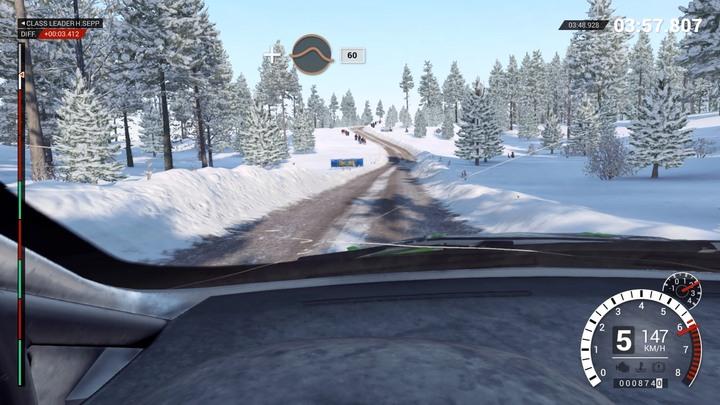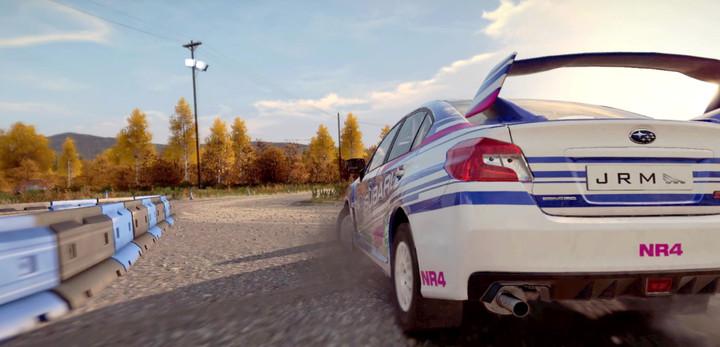Hints for beginners | Tips
Last update:

If you can’t hear the co-driver clear enough, the same information, in form of signs, will be displayed in the upper part of the screen.
This chapter will mention a couple of hints that can be very useful for players who don’t know the DiRT series.
Pay attention to co-driver’s instructions – it won’t be easy at first. Listen for the number that represents bend angles (1-6, where six is the gentlest bend) and information, whether cutting the curves is possible. If it’s possible, and you decide to take the internal side, you could get stuck or even roll over your car.
We highly recommend the simulation mode. In the default settings, the car is “resistant” to skidding. Driving such vehicles can be easier but may not grant you higher score or provide more fun.
You need to master the manual transmission – this will let you gain more control over the vehicle and speed.
Sometimes, it’s better to lose one position, rather than damage your vehicle badly. You may run out of time to repair your car before another stretch.
After each stretch, wash your car – this will improve your image and reputation.
Don’t purchase cars in advance – sometimes, when you unlock a new license, you can receive a new vehicle. It’s possible that you have already purchased the same car (or it is from the same class, as you always receive vehicles of similar classes).
Sometimes, on your way, random errors can occur e.g. damaging your transmission. If not caused by a car accident, such damages will likely stop on their own after a little while.
Driving your vehicle
Here are some tips concerning driving your vehicle:
- During the early stages of the game, and not so powerful vehicles, you will only need to slow down (take your foot off the pedal) in case of curves marked 4. Brake only in case of lower numbers.
- Gear down before direct impact with water.
- When steering rapidly near the poles, try to gear down (gear 1 or 2) and slow down significantly. This way you will rotate with your hand brake with little speed involved (just turn the back of your car, instead of making the entire curve in a single skid). The only exception is the asphalt, as you won’t lose too much speed, and thus you can go with a wider angle.
- Do not overuse your hand brake, especially when the turn is not that difficult.
- Don’t use the service brake on curves! Just use the hand brake (if the bend angle is narrow enough).
- Avoid damaging your vehicles at any cost. You will lose time, crashing into people will cause penalties, and you will damage your car – each repair will cost you.
- Still facing problems with curves? Go to the settings and reduce the overall number of opponents and adjust the gear to the number that determines the curve. It doesn’t work all the time but for the most time it should be good enough (except 5 and 6). E.g. use gear III in case of curves marked with number 3.

Don’t approach the turns at full speed, especially when the counter points towards the red line. Depending on the drive and surface slow down to pass the curve at a narrow angle:
- It’s best to keep the vehicle moving – speed up or slow down. However, in case of many turns, you should stick to low engine speed (around 4 thousand), and avoid towing and/or rotation. You can also take your foot of the pedal and speed up when you are halfway through the curve – if you do it earlier, the angle at which you leave the turn will change (thus, watch out when driving down the hill with curves).
- When approaching narrow turns (3 or lower) slow down significantly. The speed at which you leave the turn is what really matters.
- When using faster vehicles (e.g. R5 class), try to skid when approaching turns (without using the break but using the steering wheel rapidly). Powerful cars with 4x4 can immediately end the skid (does not apply to A class cars).
You are not permitted to copy any image, text or info from this page. This site is not associated with and/or endorsed by the Codemasters Software or Codemasters Software. All logos and images are copyrighted by their respective owners.
Copyright © 2000 - 2025 Webedia Polska SA for gamepressure.com, unofficial game guides, walkthroughs, secrets, game tips, maps & strategies for top games.
